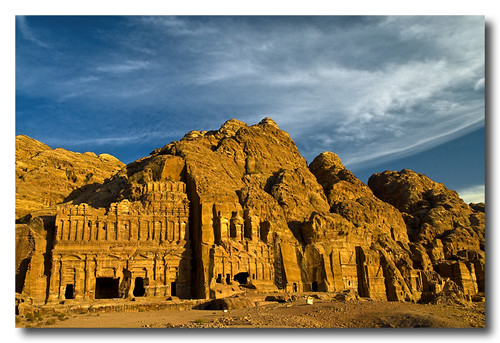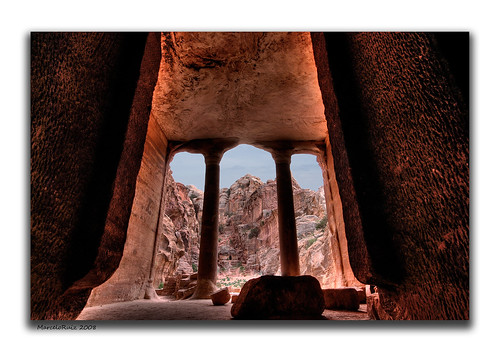Ajoobay and Ajooba: Great wall of China
The Great Wall of China
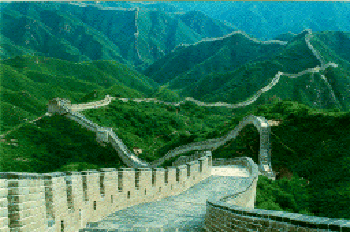
The Great Wall of China is a series of stone and earthen fortifications in China, built, rebuilt, and maintained between the 5th century BC and the 16th century to protect the northern borders of the Chinese Empire during the rule of successive dynasties. Several walls, referred to as the Great Wall of China, were built since the 5th century BC. The most famous is the wall built between 220 BC and 200 BC by the first Emperor of China, Qin Shi Huang; little of it remains; it was much farther north than the current wall, which was built during the Ming Dynasty.
The Great Wall is the world's longest human-made structure, stretching over approximately 6,400 km (4,000 miles) from Shanhaiguan in the east to Lop Nur in the west, along an arc that roughly delineates the southern edge of Inner Mongolia, but stretches to over 6,700 km (4,160 miles) in total. It is also the largest human-made structure ever built in terms of surface area and mass. At its peak the Ming Wall was guarded by more than one million men. It has been estimated that somewhere in the range of 2 to 3 million Chinese died as part of the centuries-long project of building the wall.
The first major wall was built during the reign of the First Emperor, the main emperor of the short-lived Qin dynasty. This wall was not constructed as a single endeavor, but rather was created by the joining of several regional walls built by the Warring States. It was located much further north than the current Great Wall, and very little remains of it. A defensive wall on the northern border was built and maintained by several dynasties at different times in Chinese history. The Great Wall that can still be seen today was built during the Ming Dynasty, on a much larger scale and with longer lasting materials (solid stone used for the sides and the top of the Wall) than any wall that had been built before. The primary purpose of the wall was not to keep out people, who could scale the wall, but to insure that semi-nomadic people on the outside of the wall could not cross with their horses or return easily with stolen property.
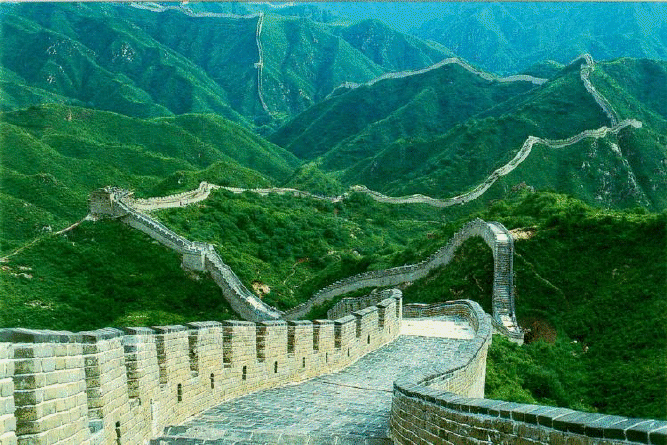
- 208 BC (the Qin Dynasty) 1st century BC (the Han Dynasty) 1138 - 1198 (the Five Dynasties and Ten Kingdoms Period) 1368-1620 (from Hongwu Emperor until Wanli Emperor of the Ming Dynasty)
Qin Shi Huang conquered all opposing states and unified China in 221 BC, establishing the Qin Dynasty. Intending to impose centralized rule and prevent the resurgence of feudal lords, he ordered the destruction of the wall sections that divided his empire along the former state borders. To protect the empire against intrusions by the Xiongnu people from the north, he ordered the building of a new wall to connect the remaining fortifications along the empire's new northern frontier.
Transporting the large quantity of materials required for construction was difficult, so builders always tried to use local resources. Stones from the mountains were used over mountain ranges, while rammed earth was used for construction in the plains. The peasants who died working were buried inside the wall, to be unearthed later by archaeologists. There are no surviving historical records indicating the exact length and course of the Qin Dynasty walls. Most of the ancient walls have eroded away over the centuries, and very few sections remain today. Possibly as many as one million people died building the Wall under the Qin Dynasty.
Later, the Han, Sui, Northern and Jin dynasties all repaired, rebuilt, or expanded sections of the Great Wall at great cost to defend themselves against northern invaders.
The Great Wall concept was revived again during the Ming Dynasty following the Ming army's defeat by the Oirats in the Battle of Tumu in 1449. The Ming had failed to gain a clear upper-hand over the Mongols after successive battles, and the long-drawn conflict was taking a toll on the empire. The Ming adopted a new strategy to keep the nomadic Mongols out by constructing walls along the northern border of China. Acknowledging the Mongol control established in the Ordos Desert, the wall followed the desert's southern edge instead of incorporating the bend of the Huang He.
Unlike the earlier Qin fortifications, the Ming construction was stronger and more elaborate due to the use of bricks and stone instead of rammed earth. As Mongol raids continued periodically over the years, the Ming devoted considerable resources to repair and reinforce the walls. Sections near the Ming capital of Beijing were especially strong.
Towards the end of the Shun Dynasty, the Great Wall helped defend the empire against the Manchu invasions that began around 1600. Under the military command of Yuan Chonghuan, the Ming army held off the Manchus at the heavily fortified Shanhaiguan pass, preventing the Manchus from entering the Liaodong Peninsula and the Chinese heartland. The Manchus were finally able to cross the Great Wall in 1644, when the gates at Shanhaiguan were opened by Wu Sangui, a Ming border general who disliked the activities of rulers of the Shun Dynasty. The Manchus quickly seized Beijing, and defeated the newly founded Shun Dynasty and remaining Ming resistance, to establish the Qing Dynasty.
Under Qing rule, China's borders extended beyond the walls and Mongolia was annexed into the empire, so construction and repairs on the Great Wall were discontinued. A counterpart wall to the Great Wall in the south was erected to protect and divide the Chinese from the 'southern barbarians' called Miao (meaning barbaric and nomadic).
Notable Areas
The following three sections are in Beijing municipality, which were renovated and which are regularly visited by modern tourists
- The "North Pass" of Juyongguan pass, known as the Badaling. When used by the Chinese to protect their land, this section of the wall has had many guards to defend China's capita, Beijing. Made of stone and bricks from the hills, this portion of the Great Wall is 7.8 meters (25.6 ft) high and 5 meters (16.4 ft) wide.
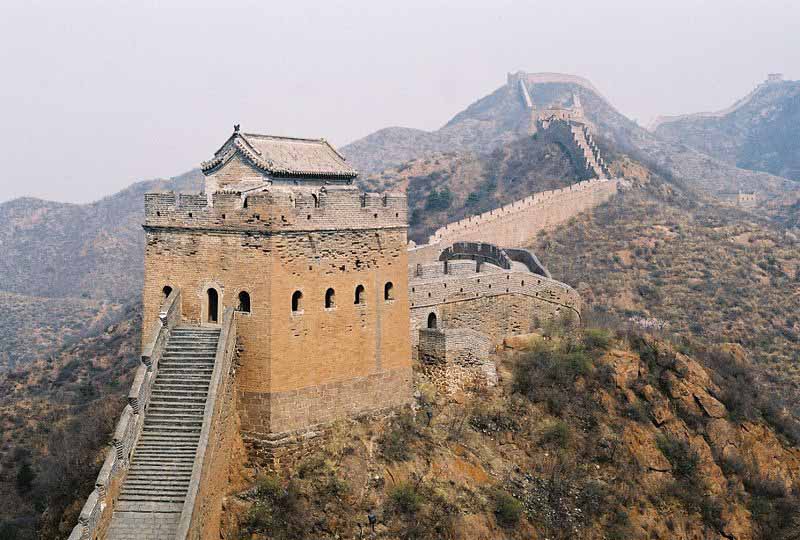
- One of the most striking sections of the Ming Great Wall is where it climbs extremely steep slopes. It runs 11 kilometers (7 mi) long, ranges from 5 to 8 meters (16-26 ft) in height, and 6 meters (19.7 ft) across the bottom, narrowing up to 5 meters (16.4 ft) across the top. Wangjinglou is one of Jinshanling's 67 watchtowers, 980 meters (3,215 ft)above sea level.
- South East of Jinshanling, is the Mutianyu Great Wall which winds along lofty, cragged mountains from the southeast to the northwest for approximately 2.25 kilometers (about 1.3 miles).It is connected with Juyongguan Pass to the west and Gubeikou to the east.
Characteristics
Before the use of bricks, the Great Wall was mainly built from earth, stones, and wood.
During the Ming Dynasty, however, bricks were heavily used in many areas of the wall, as were materials such as tiles, lime, and stone. The size and weight of the bricks made them easier to work with than earth and stone, so construction quickened. Additionally, bricks could bear more weight and endure better than rammed earth. Stone can hold under its own weight better than brick, but is more difficult to use. Consequently, stones cut in rectangular shapes were used for the foundation, inner and outer brims, and gateways of the wall. Battlements line the uppermost portion of the vast majority of the wall, with defensive gaps a little over 30 cm (one foot) tall, and about 23 cm (9 inches) wide.
The steps that form the Great Wall of China are very steep and tall in some areas. Tourists often become exhausted climbing the wall and walk no more than a kilometre or two (around a mile).
Condition
While some portions north of Beijing and near tourist centers have been preserved and even reconstructed, in many locations the Wall is in disrepair. Those parts might serve as a village playground or a source of stones to rebuild houses and roads.
Sections of the Wall are also prone to graffiti and vandalism. Parts have been destroyed because the Wall is in the way of construction. No comprehensive survey of the wall has been carried out, so it is not possible to say how much of it survives, especially in remote areas. Intact or repaired portions of the Wall near developed tourist areas are often frequented by sellers of tourist kitsch.
More than 60 kilometres (37 mi) of the wall in Gansu province may disappear in the next 20 years, due to erosion from sandstorms. In places, the height of the wall has been reduced from more than five meters (16.4 ft) to less than two meters. The square lookout towers that characterize the most famous images of the wall have disappeared completely. Many western sections of the wall are constructed from mud, rather than brick and stone, and thus are more susceptible to erosion.
The materials used are those available near the site of construction. Near Beijing the wall is constructed from quarried limestone blocks. In other locations it may be quarried granite or fired brick. Where such materials are used, two finished walls are erected with earth and rubble fill placed in between with a final paving to form a single unit. In some areas the blocks were cemented with a mixture of glutinous rice and eggwhite.In the extreme western desert locations, where good materials are scarce, the wall was constructed from dirt rammed between rough wood tied together with woven mats.
The Wall is included in lists of the "Seven Medieval Wonders of the World" but was of course not one of the classical Seven Wonders of the World recognized by the ancient Greeks. The Wall was made a UNESCO World Heritage Site in 1987.
There is a longstanding disagreement about how visible the wall is in space. Richard Halliburton's 1938 book Second Book of Marvels said the Great Wall is the only man-made object visible from the moon. This myth has persisted, assuming urban legend status, sometimes even entering school textbooks. The Great Wall simply cannot be seen by the unaided eye from the distance of the moon. Even its visibility from near-earth orbit is questionable.
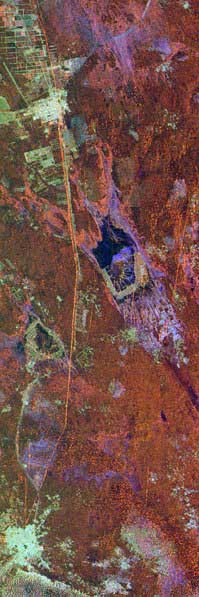
The Great Wall of China as seen in a false-color radar
image from the Space Shuttle, taken in April 1994
From low-earth orbit, about a thousand times nearer than the moon, it may be visible under favorable conditions. Features on the moon that are dramatically visible at times can be undetectable on others, due to changes in lighting direction. The Great Wall is only a few meters wide - sized similar to highways and airport runways - and is about the same color as the soil surrounding it.Veteran U.S. astronaut Gene Cernan has stated: "At Earth orbit of 160 km to 320 km high, the Great Wall of China is, indeed, visible to the naked eye." Ed Lu, Expedition 7 Science Officer aboard the International Space Station, adds that, "...it's less visible than a lot of other objects. And you have to know where to look."
A recent photograph taken from the International Space Station appears to confirm that China's Great Wall can be seen with the naked eye after all. Leroy Chiao, a Chinese-American astronaut, took what the state-run China Daily newspaper says is the first photographic evidence that the Great Wall could be seen from space with the naked eye, under certain favorable viewing conditions and if one knows exactly where to look.
Battle Forts and Watch Towers
The wall is complemented by defensive fighting stations, to which wall defenders may retreat if overwhelmed. Each tower has unique and restricted stairways and entries to confuse attackers. Barracks and administrative centers are located at larger intervals. In addition to the usual military weapons of the period, specialized wall defense weapons were used. Reproductions of weapons are displayed at the wall.

Battle forts built on the summits of hills.
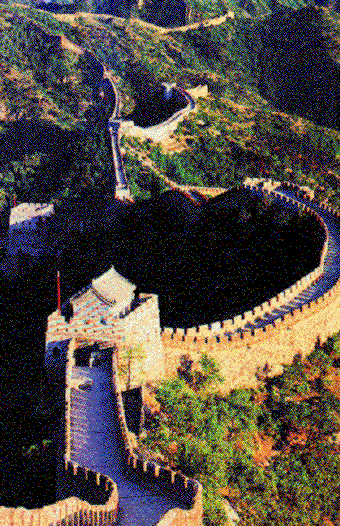
The Mutianyu section of the Great Wall, 70 kilometers northeast of Beijing, is linked to the Gubeikou section on the east and the Badaling section on the west. It is one of the best sections of Great Wall. The Mutianyu section is crenellated for watching and shooting at the invading enemy. Some of the battle forts on the wall are as close as 50 meters apart.






































